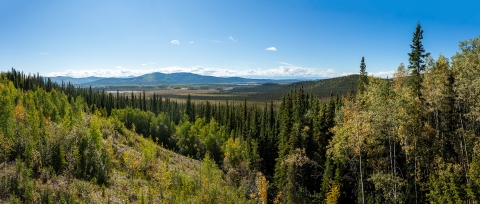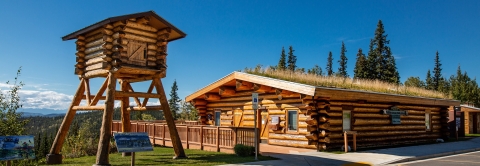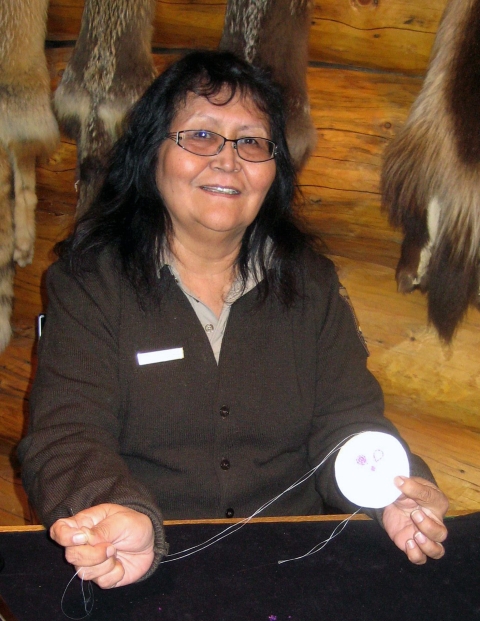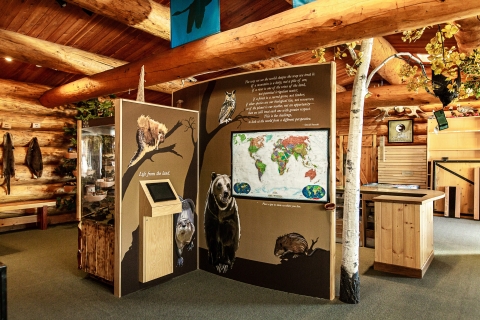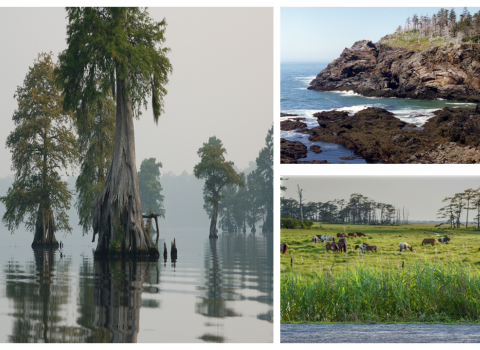One of Sylvia Pitka’s earliest chores was caring for the family dogs. That’s not unusual in American households, but these dogs were more than pets: they were hard-working household members, essential to the family’s prosperity. And their health and well-being depended on Sylvia’s diligence.
“I had to cook their food, feed them, and gather grass for their beds,” she says. “We needed those dogs as much as they needed us. We got around on dog sleds back then, and they made it possible for us to fish, hunt and trap.”
Sylvia, her five siblings and father lived in Northway, a tiny Upper Tanana Athabascan community near Alaska’s Tetlin National Wildlife Refuge. Fishing, hunting and trapping weren’t mere avocations for the family — their lives literally depended on the resources they could get from the rivers and forests.
“Like most tribal members back then, we followed a true subsistence lifestyle,” says Sylvia. “We caught burbot, grayling, pike and whitefish and preserved them. We killed moose and caribou for our meat, and we earned money for other essentials from furs. The land gave us everything.”
Sylvia’s mother died when she was young, and her father schooled her in the essential skills — and ethics — of subsistence living.
“He used to tell us about the first moose he killed,” Sylvia says. “He was 16, and moose weren’t as common around Northway as they are now, and he really had to hunt hard.”
When the moose carcass was brought back to the village, Sylvia’s grandfather insisted on distributing much of the meat to other community members.
“My father asked why, because our own family was having a pretty hard time of it,” says Sylvia. “My family needed that meat. And my grandfather said, ‘This is how everyone in the village survives — by sharing. A lot of people are hungry. So you share, and it comes back to you.’ And my father emphasized that lesson to us kids, and we’ve never forgotten it.”
While Sylvia learned how to hunt, fish and trap from her father, she lacked the skills typically practiced and taught by women in Upper Tanana Athabascan culture.
“So when I was 11, my dad sent me to my aunt so I could learn about beadwork, birch bark basket making, and things like that,” Sylvia says. “I loved working with beads, though I was never too thrilled about basket making. But it was important that I learned how to do it.”
As Sylvia grew up, her dad and uncle felt she needed to broaden her horizons beyond Northway. So after graduating from eighth grade, she was sent away to the Mt. Edgecumbe Boarding School in Sitka for her high school education. Many native kids from Northway followed the same educational path, and some found separation from family and familiar environs jarring, acknowledges Sylvia.
“But I really liked it,” she says. “I met kids from all around Alaska, and I made a lot of new friends. Then I got to spend my junior year at the Chemawa Indian School in Salem, Oregon, and that was fantastic. The weather was so nice compared to Sitka! And when some friends and I got good grades in math, our teacher took us to a Creedence Clearwater Revival concert. I remember everything about that concert — and I still like listening to Creedence today.”
Sylvia returned to Mt. Edgecumbe the following year and earned her high school diploma.
“Then I went back home,” she says. “Back home to Northway. And I’ve been here ever since.”
Sylvia worked for a while with the Youth Conservation Corps, and then took a position as a community health aide. It was challenging but rewarding work, and she stayed with it for 32 years.
“In a small community like Northway, you do it all if you’re in health care,” Sylvia says. “I’d draw blood, do lab work, help deliver babies, take care of people who were ill, respond to accidents, make home visits. Sometimes I’d get up at 2 or 3 in the morning due to some emergency, and I wouldn’t get home until 9 or 10 at night. I enjoyed it, and I enjoyed serving my community. But it was stressful, and it took a toll. At a certain point my doctor told me the stress was getting to be too much, and that I needed to find something else to do.”
Sylvia had always wanted to work for the U.S. Fish and Wildlife Service, so she applied for a position at the Tetlin National Wildlife Refuge after retiring from health care.
“I didn’t get it, but then I attended a class on applying for federal positions, and it was really helpful. And in 2010 I was hired as a Refuge Information Technician for the Tetlin Visitor Center.”
Sylvia’s duties at the Center are manifold, but she’s first and foremost an ambassador for Tetlin, the Upper Tanana Athabascan community and the U.S. Fish and Wildlife Service at large. She’s the first person many visitors encounter after crossing the Canadian border on the Alaska Highway.
“When people first meet me, most of them want to know about my culture and traditions,” Sylvia says. “Some think I’m an ‘Eskimo.’ So I explain about the indigenous people of Alaska — not just Athabascan people, but the Iñupiat, Yupik and Aleut, and the Eyak, Tlingit, Haida along the Southeast Coast. I take out maps and show them where each native group lives, and they go away, I think, with a much deeper understanding of both Alaska and Alaskans.”
Tim Lorenzini, Tetlin’s Supervisory Park Ranger, says Sylvia is essential to the success of visitor center operations.
“The center is located about 90 miles from where I work at refuge headquarters in Tok,” says Tim, “but I never worry about whether Sylvia will be there to open and close the doors on time. Tens of thousands of people come through that center each year, and Sylvia represents both the U.S. Fish and Wildlife Service and the Upper Tanana Athabascan community to each one of those visitors.”
Sylvia works for the U.S. Fish and Wildlife Service about six months of the year, and still pursues a subsistence way of life when the center closes down at the end of tourist season.
“My husband’s people have a fish camp on the Yukon, so we go up there for salmon,” she says, “and we still get whitefish and pike from the local rivers, and hunt for caribou and moose. Most of my grandkids live in Fairbanks, and they come down and hunt during the moose season and take meat back with them. So in a very real way they’re still participating in subsistence traditions.”
Native communities are under intense pressure in many parts of North America, but Sylvia remains optimistic that Upper Tanana Athabascan culture will not just survive — it’ll thrive.
“I speak our language, and I taught it to my kids, and they’re teaching it to their kids,” she says. “We know who we are, and we maintain our traditions. That isn’t going to change.”
When did you join the U.S. Fish and Wildlife Service?
In 2010.
What do you think people would find most surprising about your job?
That so much interpretation is involved. We greet and welcome people, but we’re also here to inform them. Visitors are really interested in Native cultures, and you have to be able to educate them in ways that hold their attention. Sometimes it’s answering a lot of questions, and sometimes it’s more involved. For example, I regularly conduct programs at refuge campgrounds where I show people how to make traditional birch bark baskets.
What inspires you most about Alaska?
The land. Its whiteness in winter. It’s all so beautiful.
What is your foremost concern about Alaska’s wildlife resources?
That people don’t understand basic conservation. As a child, one of the first things I was taught is that you only kill what you need to survive. You don’t hunt moose or caribou when they’re having their young. When you’re trapping beaver, you don’t clean out an entire beaver house — you do that and they won’t come back. People need to remember these simple truths.
When I’m not at work, I’m….
…spending time with my grandchildren, teaching them our language and our traditions.
What’s the greatest misconception people have about Alaska?
Many people don’t really understand how cold it can get in interior Alaska. During the winter, we regularly have to put up people who get stranded on the highway by the weather. One time when we were returning from Fairbanks, we picked up this young guy from Japan who was hitchhiking. There was a lot of snow, and he was dressed in light clothes. Boy, he was cold. He would’ve died out there if someone hadn’t picked him up.
Also, people may not understand how silent it can be here. When I go down to the Lower 48, all the noise bothers me. I can’t wait to get back up here, where it’s quiet except for the sounds of nature.
What’s your most treasured memory of Alaska or your job?
I have many, many incredible memories about the land, the animals and the fish. About my job? The day I was hired. I was so happy to work for Fish and Wildlife, and I still am. I love my work.
What advice would you give people who want to work for the U.S. Fish and Wildlife Service?
Just be ready to learn. I’ve learned a lot through my work — not just about interacting with visitors, but about the land and the wildlife.
What animal inspires you most?
That’s a tough one. I’d have to say I’m moved by how all the animals interact with each other. The moose feed, and the wolf eats the moose. They all have to live, and they maintain a balance. There’s a deep meaning to it. That’s what inspires me.
Story by Glen Martin, freelance writer/former San Francisco Chronicle environmental reporter. Compiled by Andrea Medeiros and Katrina Liebich, External Affairs.
In Alaska we are shared stewards of world renowned natural resources and our nation’s last true wild places. Our hope is that each generation has the opportunity to live with, live from, discover and enjoy the wildness of this awe-inspiring land and the people who love and depend on it.


